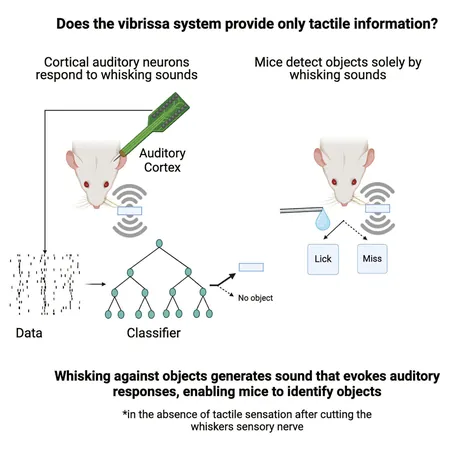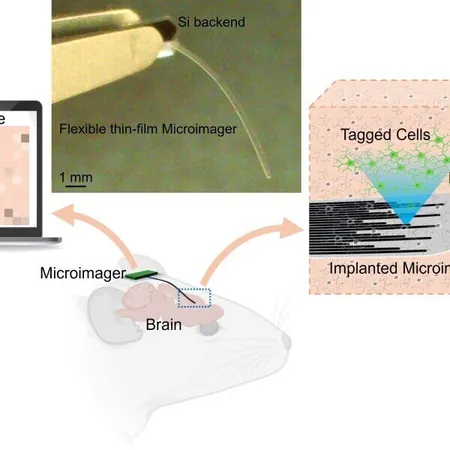
Unlocking the Secrets of Mouse Whiskers: A New Frontier in Sensory Perception
2025-05-15
Author: Nur
Deep within the burrows of our furry friends, mice navigate their world largely through their delicate whiskers, tapping against everything nearby. Traditionally seen as a tool for touch, new research from the Weizmann Institute of Science flips this perception on its head.
Whisking: More Than Just Touch
Recent findings, published in Current Biology, unveil the intricate sounds generated by whiskers during this behavior—known as 'whisking'—and how these sounds are encoded within the mice's auditory cortex. Prof. Ilan Lampl, who led the study, notes that until now, the idea of whiskers producing audible sounds that mice could hear was largely overlooked.
A Multisensory Breakthrough
This groundbreaking study sheds light on the complex interplay of the senses. Just like us, mice tend to merge sensory information. For example, when we rummage through a bag of snacks, the sound of crinkling wrappers adds an auditory layer to our tactile experience.
Recording the Sounds of Whisking
To kick off their research, Lampl's team, including Dr. Ben Efron and collaborators, recorded the sounds emitted by mouse whiskers against various surfaces, such as dried leaves and aluminum foil. Using ultra-sensitive microphones capable of capturing frequencies beyond human hearing, the team ensured a close approximation to the distance between the mice's ears and whiskers.
Neural Responses Unearthed
The next phase involved dissecting the auditory activity within the mice as they whisked against different objects. Results revealed that the auditory cortex reacted to these whisker sounds, affirming that mice can perceive them as distinct auditory inputs, independent of tactile sensation. Even when touch was disabled, the mice still processed the sounds—indicating an elaborate form of sensory integration.
Can Mice Use Sounds for Recognition?
To further investigate this sensory integration, the researchers employed AI to assess whether auditory cues could aid in object recognition. Astonishingly, machine-learning models trained on both sound and neural activity managed to identify objects with equal accuracy—pointing towards a strong possibility that mice utilize these sounds to evaluate their environment.
A Surprising Experiment
In an impressive behavioral twist, the team trained mice with disrupted touch sensitivity to recognize aluminum foil based solely on its whisker-generated sounds. The mice consistently responded to these sounds, solidifying the connection between auditory input and environmental awareness.
Evolutionary Implications
Lampl hypothesizes that this evolution of multimodal perception may have arisen as a survival strategy; whisking produces quieter sounds than walking, enabling mice to move stealthily across vulnerable terrains without attracting predators like owls.
Future Innovations on the Horizon
This study not only enriches our understanding of sensory systems in mice but also propels new avenues for research on how brains fuse varied sensory inputs. Such insights could revolutionize technology—from advanced prosthetics to sensory rehabilitation—potentially enhancing perception for the visually impaired. Moreover, robotics could also benefit, as the integration of different sensor types remains a formidable challenge in designing intelligent machines.
Efron emphasizes that the mouse's whisking system may inspire innovative early warning sensors, crucial for collision avoidance in scenarios where visibility is compromised. The implications of this research are abundant, paving the way for a deeper understanding of sensory interaction in both animals and machines.




 Brasil (PT)
Brasil (PT)
 Canada (EN)
Canada (EN)
 Chile (ES)
Chile (ES)
 Česko (CS)
Česko (CS)
 대한민국 (KO)
대한민국 (KO)
 España (ES)
España (ES)
 France (FR)
France (FR)
 Hong Kong (EN)
Hong Kong (EN)
 Italia (IT)
Italia (IT)
 日本 (JA)
日本 (JA)
 Magyarország (HU)
Magyarország (HU)
 Norge (NO)
Norge (NO)
 Polska (PL)
Polska (PL)
 Schweiz (DE)
Schweiz (DE)
 Singapore (EN)
Singapore (EN)
 Sverige (SV)
Sverige (SV)
 Suomi (FI)
Suomi (FI)
 Türkiye (TR)
Türkiye (TR)
 الإمارات العربية المتحدة (AR)
الإمارات العربية المتحدة (AR)